Media Effects Research Lab - Research Archive
Effects of interactivity, animation, and ad shape on attitudes toward imus
Student Researcher(s)
Jinhee Kim (Ph.D Candidate);
Faculty Supervisor
FOR A COMPLETE REPORT OF THIS RESEARCH, SEE:
Sundar, S. S. & Kim, J. (2004, May). Interactivity and persuasion: Influencing attitudes with information and involvement. Paper presented to the Communication and Technology division at the 54th annual convention of the International Communication Association (ICA), New Orleans, LA.
INTRODUCTION
Interactivity effects have been largely tested with computers and Websites but not yet with online advertisements. The recent arrival of interactive messaging/marketing units (IMUs) seems to provide a real ground for testing persuasive effects of advertisement interactivity. The present investigation systematically varied the levels of interactivity in IMUs, and tracked both the direct effects of interactivity on user attitudes and the combinatory effects of interactivity with animation and ad shape, two common variables in IMUs.
HYPOTHESES AND RESEARCH QUESTION
Interactivity
The present study operationalized three levels of advertisement interactivity based on the Rafaeli’s (1988) contingency model of interactivity. Previous studies have shown that interactivity promotes user engagement with content and favorable evaluations toward Web sites. This leads to the following hypotheses:
H1: Higher the level of ad interactivity, greater its perceived interactivity.
H2: Higher the level of ad interactivity, more positive the attitudes toward the ad (Aad).
H3: Higher the level of ad interactivity, more positive the attitudes toward the product.
Animation
As a formal feature of the new medium, animation has proven to be powerful tool for generating desirable advertising effects: higher arousal, positive attitude toward both the ads and the Website, better memory for ad content, etc. This leads to the following hypotheses:
H4: Animated ads will be rated higher in attitude toward the ad than static ads.
H5: Animated ads will generate more positive attitudes toward the product than static ads.
Ad Shape
Web ads appear in numerous formats, but IMUs usually happen to be in one of two formats – banner and big-box (a large square ad). Paucity of research investigating this variable prompts us to pose the following research question:
RQ1: For IMU users, what is the relationship between shape of the ad (banner vs. square) and user attitudes toward the ads as well as the products advertised?
Combination Effects
If interactivity, animation, and ad shape are peripheral cues, then they are likely to aid heuristic processing of ad information. Further, multiple peripheral cues would be more powerful than single ones in promoting the persuasive ability of online ads. Given this, the following prediction was generated:
H6: Interactivity, Animation, and Ad Shape will have additive effects on user attitudes toward the ads as well as the products advertised.
METHOD
All participants (N = 48) in a 3 (Interactivity: Low, Medium, High) x 2 (Animation: Static, Animated) x 2 (Ad Shape: Banner, Square) experiment design were exposed to 12 Web pages containing news articles, with each page containing a stimulus ad. They saw one of three different samples of stimulus ads in one of four orders. After browsing through each Web page for a maximum of 90 seconds, they filled out a paper-and-pencil questionnaire eliciting their attitudes toward the ad and the product advertised in it.
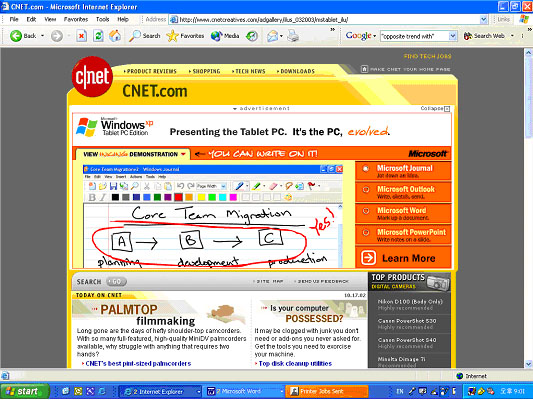
RESULTS
H1: Supported. Low-interactive ads were rated the lowest on perceived interactivity, whereas high-interactive ads were rated significantly higher, with medium-interactive ones falling in between the two on this measure.
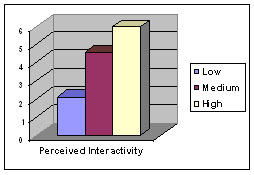
H2: Supported. Low-interactive ads were rated lowest on attitude toward the ad and high-interactive ones rated significantly more positive, with medium-interactive ads falling in between the two on this measure.
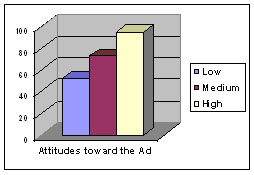
H3: Supported. Participants reported that the low-interactive ads led to the least level of perceived product knowledge, significantly lower than medium- and high-interactive ads. In addition, participants rated low-interactive ads lowest on product involvement, high-interactive ads significantly higher, with medium-interactive ads falling in between the two.
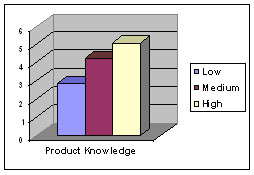
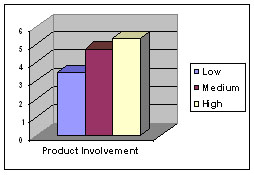
H4: Supported. Participants showed more positive attitude toward animated ads than static ads.
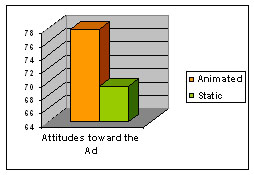
H5: Not Supported. Participants reported a higher level of perceived product knowledge and product involvement for static ads than for animated ads.
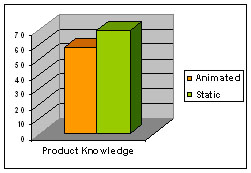
H6: Partially Supported. The two-way interactions between animation and ad shape reveal additive consequences, with animated square ads being most successful in contributing to positive attitude toward ads (Figure 1). In addition, the two-way interactions between animation and interactivity showed that the relative advantage enjoyed by animated over static ads in promoting attitude toward ads (Figure 2). However, high interactivity appears to be an overpowering peripheral cue that negates the relative advantage of animated ads over static ads
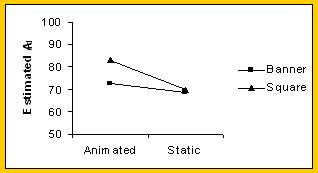
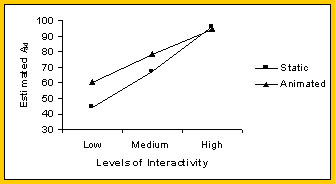
RQ1: Participants showed more positive attitudes toward square ads than banner ads. Similarly, they reported higher level of product involvement for square ads than for banner ads. However, participants reported a higher level of perceived product knowledge for banner ads than for square ads.
CONCLUSION
The present study shows that interactivity is a strong cue aiding the persuasive function of online ads. This means that the contingency-based conceptualization of interactivity is applicable not just to Web sites but also to Web advertisements. Animation is an important cue that positively influence attitude toward the ad but negatively affects perceived product knowledge and product involvement, suggesting the distractive potential of animation. It is also found that the effects of peripheral cues are not always additive. More importantly, it appears that ad interactivity enhances user involvement with product by providing more product information hence leads to more positive evaluations. This ability stands in striking contrast to most other formal features (e.g., animation or ad shape), which tend to be, at least perceptually, more cosmetic and less informational.
For more details regarding the study contact
Dr. S. Shyam Sundar by e-mail at sss12@psu.edu or by telephone at (814) 865-2173

